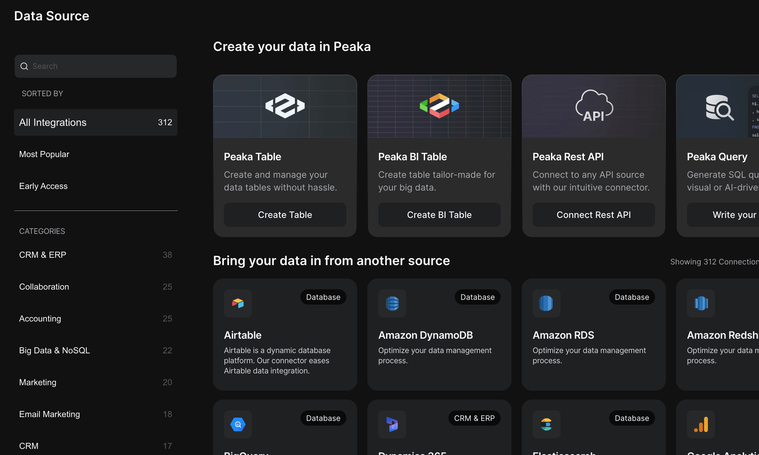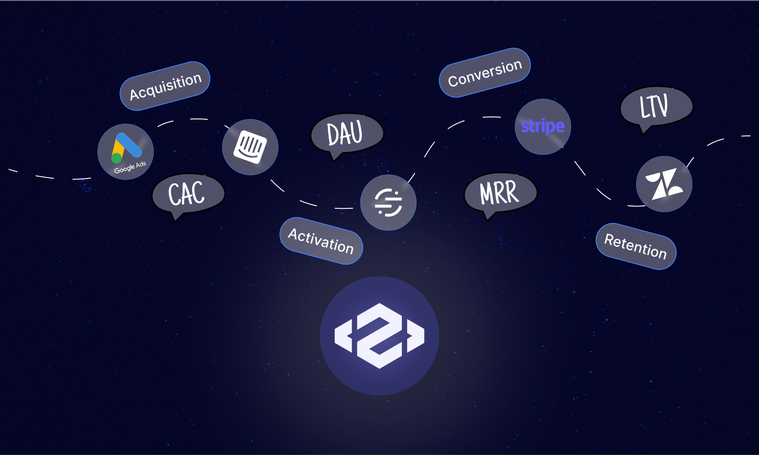How to Get Started with Customer 360
Introduction
Ever since COVID, raising capital has become increasingly challenging, with the market growing more competitive by the day. One crucial insight I've gained over the years is the immense value of your data. The more you analyze your product/customers, the higher your chances of success.
Businesses are flooded with an unprecedented volume of data, necessitating the need for a more data-centric approach. From website interactions to social media engagements and the comprehensive spectrum of customer journeys, companies are collecting extensive datasets, often characterized as a Customer 360° view. However, without suitable tools and methodologies, this data remains merely a non-aggregated collection of numbers and statistics. This is where the importance of data unification and data stack initiatives becomes evident.

Customer 360° encompasses the acquisition channels, 'aha moments,' preferences, and behavioral patterns of customers when interacting with a product. Various tools are designed to collect data across these customer journey stages, each catering to specific aspects of Customer 360°. By integrating these data sources onto a unified platform, businesses can significantly improve their understanding of customer behaviors.
Before exploring data source unification in detail, let's examine the components of Customer 360° and the importance of each step.
Components of Customer 360°
Software solutions typically navigate through four stages of the customer journey: Awareness, consideration, evaluation, and decision.
-
Awareness: Potential customers are often unaware of your product; they recognize that they have a problem needing a solution, so they commence their search.
-
Consideration: Upon discovering your product, they start considering various options at their disposal.
-
Evaluation: After narrowing down their options, they evaluate how your product addresses their pain point (often signs up for free trials)
-
Decision: Ultimately decide if they want to convert or switch to an alternative.
Acquisition
Customer acquisition marks the beginning of the awareness stage—the crucial process of finding your ideal customer profile (ICP) and raising awareness about the solution you offer. This phase involves a series of well-defined marketing and sales strategies aimed at creating brand recognition and capturing the interest of the target audience. While crucial, focusing solely on top-of-the-funnel activities without refining other stages may hinder conversion rates. It’s undeniably vital, but an excessive focus on top of the funnel (ToFu) can let your customers down over time. Filling up the ToFu without perfecting the other stages will fail them to convert into your product.
Some effective tools companies use at this segment are Google Ads, GA4, CRMs, and Intercom.
Activation
The activation process guides customers to the 'aha moment,' showcasing the advantages of your product and encouraging its full use. By doing so, you’ll motivate them to use your product frequently. Without a proper onboarding and a customer activation funnel, the leads a company generates usually fail to convert into active users. The activation phase is often the most challenging in the early days, as it necessitates customers interacting with the product—hence, it often gets pushed to later days (will be the end of your venture). One should get qualified people on board and get them to interact with the product, even if they come in as a design partner (basically non-paying customer who helps with the design). As mentioned earlier, getting rich engagement data is the way to go.
To navigate your customers towards your value proposition, one has to capture their behavioral data. This can be done through various means, including databases, NoSQL databases, and event data capture tools like Segment and Jitsu.
Conversion
At the end of a free trial, customers face a decision: convert to a paying customer or churn. At this juncture, the conversion process should be seamless. The pricing model should be clear, the backend transaction architecture—ideally utilizing solutions like Stripe—should operate seamlessly, and the user interface (UI) must be intuitive, avoiding unnecessary complexity.
While seemingly straightforward, many companies often struggle with conversions due to complex UI designs. Tools like Stripe or Chargebee are commonly used for payment data capture, with B2B witnessing the emergence of startups like Slope.
Retention
Transitioning to a paid subscription marks a new journey—the metrics previously collected about the customers become less relevant. I can’t emphasize enough how important collecting data is at this stage—yet many startups lack the infrastructure for data analysis; many cannot even articulate the basics of their user engagement. This is the biggest problem with modern-day startups: Most founders are unaware of the need to establish a pipeline for analyzing and cross-referencing engagement data. Top Highlight
Many studies revealed that more than 50 percent of the customers churn within the first year. It’s highly likely that the main reason is that the company has no idea what customers like or hate about the product. Up until this point, most efforts are focused on pre-sales activities. For many companies, post-sales engagement is limited to launching an affiliate or referral program, often without any supporting data.
Those who succeed in scaling always show post-sale tests as one of the main reasons for their scale. YC Group Partner Gustaf highlights how Airbnb conducted thousands of A/B tests, focusing on details as little as the shape of the Gmail logo in their referral emails. EVERY. DATA. COUNTS.
Why Customer 360°
Now that we’ve gone through all the segments, we can talk about why implementing a Customer 360° is not just beneficial—it’s essential for survival and growth in the early stage companies. Implementing Customer 360° is essential for startups seeking to understand their customers comprehensively, combining pre-sales and product analytics data for a holistic view.
Peaka: The Backbone of Customer Insights
Tools like Peaka stand as the foundation for initiating a robust Customer 360°, allowing for the consolidation of diverse data sources into a central repository, simplifying the management and retrieval of information. Users can connect to a wide range of integrations—CRM systems, social media interactions, transaction records, or support engagements—to offer a holistic view of the customer.

The challenge of dealing with siloed customer data is common among startups. Each platform collects data in its unique format, resulting in fragmented insights. Data unification brings consistency and ensures a smooth data flow, revealing hidden patterns and insights that would be difficult to discern from isolated data sources.
The effectiveness of Customer 360° is enhanced through cross-sourcing. For example, behavioral data collected on a website via Posthog can be combined with transactional data and customer feedback gathered through Stripe and Typeform. This comprehensive dataset offers a multi-dimensional view of customers, enabling startups to refine their products, personalize marketing campaigns, and accurately anticipate customer needs.
Peaka can connect to more than 300 databases + SaaS tools + NoSQL + APIs in minutes… with a few clicks (yes, even to Snowflake). It processes real-time data directly from its sources, querying, caching, and blending data to establish a single source of truth. With its cutting-edge technology, Peaka is instrumental in supporting its customers' Customer 360° endeavors.
Peaka provides a scalable data infrastructure foundation, facilitating growth without the necessity for major system overhauls. This has led to our clients experiencing improved churn rates and a significant reduction in data warehouse and ETL expenses by up to 90 percent.




 Please
fill out this field
Please
fill out this field









